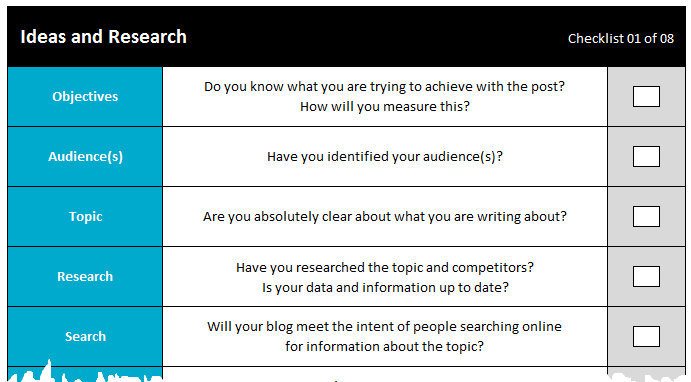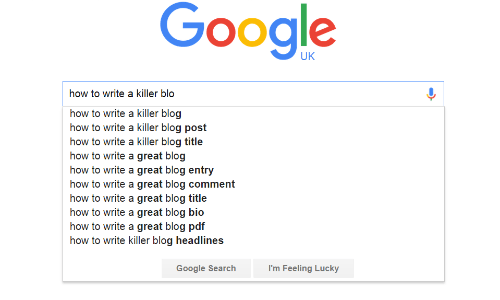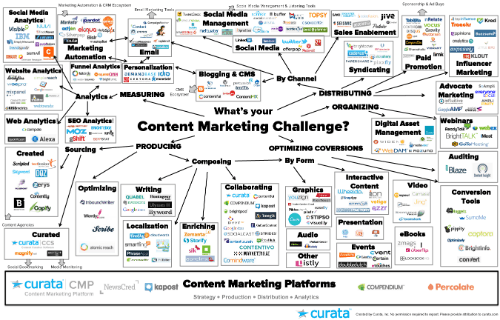8 Reasons You Need Fresh Egg’s Ultimate Blogging Best Practice Checklist
By Intern |23 Sept 2015
Blogging for a business brings with it many pressures, from thinking up new ideas to demonstrating the work is driving growth. The reality of blogging in today’s ultra-competitive environment is that attracting the leads you need requires hard work, perseverance, and no little luck.
At Fresh Egg our great team has various processes in place to get the most out of blogging, and we’ve distilled the essence of these processes into our Ultimate Blogging Best Practice Checklist. We've split the checklist into eight categories which we think are the most important themes. And these are our eight reasons for using our checklist. And they are:
- Ideas and research
- Writing
- Formatting
- Images and rich media
- Amplification
- Measurement
- Repurposing
- Publishing and refinement
And, while we can’t guarantee that the checklist help you find what blogging guru Larry Kim calls his ‘Unicorns’ – that five per cent of posts that will deliver the majority of your traffic – if you follow this process carefully, you can improve your blog and increase your chances of finding these winners.

Download our brilliant checklist to take your blogging to the next level
There’s no point in taking you through every element of the checklist in this post – just download it! – and there are already enough ‘how to blog’ blogs around, so instead, here we’ll just pull out the checklist’s key themes.
Ideas and research
Hopefully, you will have a content marketing strategy in place from which research techniques are identified and ideas can be generated. If not, here are the primary things you need to be thinking about:
- Audience – who are you writing for?
- Topic – what information do they need/problem do they need solving?
- Testing – can you find a way of testing the topics your audience could be interested in?
- Influencers – can you piggy back on an eminent blogger’s audience, perhaps by involving them in your post, so they are likely to amplify your work?
Given the above, how do you find fresh ideas and research which blog posts are suitable for your audience? There are many techniques and tools for idea generation. For beginners, a good starting point can be search behaviour. Tools such as the AdWords keyword planner and Google Trends can generate ideas.
A really simple trick is to use Google’s autosuggest feature to look at search phrases around a topic you are thinking of writing about, though the ideas will not be that refined.

These tools are a good place to start, but won’t give you the level of topicality you really need. To write great content for a blog, you need to be ahead of the curve, and that means writing about today’s hot topics, and the above tool may not help you identify the relevant trends.
Social platforms are arguably a better place to keep abreast with what is happening right now, and monitoring channels, such as Twitter, and reacting with blog posts that add something to the conversation, will help keep your site relevant.
Become an expert
But here’s a thought, why not try to become an expert in your field so that you set the agenda, rather than merely follow it? That isn’t going to happen overnight, but if you keep this as the end goal for your blogging, you’ll be heading in the right direction.
In the meantime, understanding the developing trends in your subject area and writing about them with expert opinion and original insight, can establish you as a go-to authority on the topic. What’s important is that you add something new to the debate, rather than rehashing existing ideas.
It also helps to know the influencers in your field, what interests them, and to engage with them on social media. You should look to use and develop their ideas – though be sure to credit your sources. In fact, name checking influencers and bringing your blog to their attention via social media is a tried and tested tactic in amplifying the reach of your content.
Using the knowledge you have of your audience
Another technique for generating content ideas, is to put yourself in the mind of the intended audience, and ask how you can solve the problems they have. You need to have clearly defined audience groups for this, – if you don’t, do the research now!
Writing and formatting
Now you’ve found a great blog idea, how do you go about writing and formatting the post to get the best results? Again, this isn’t the place to repeat the checklist, so we’ll just cover a few fundamentals.
Firstly, have your audience in mind when writing your post. Simply put, this means using the words and phrases that will appeal to your audience. This is usually the same words and phrases that your audience uses, which is easier said than done. However, the more you write about a subject, the more natural it will become.
It goes without saying that, in general, your writing should be accurate, written in the active voice, and use short, sharp sentences and paragraphs. But also consider breaking up your text with:
- Graphics and imagery
- Other value-add content, such as video
- Layout options such as headings, bullet points, pull-out quotes
It is also very important to consider:
- Linking strategy (internal and external linking)
- Calls to action (how will you encourage the reader to do what you want them to do next?)
- Well-optimised meta data (the important information that’s not seen on the published page)
Another great tip is to use tools to help you gauge the readability of your content. Copy and paste the written aspects of your blog into an online tool such as read-able.com. This will assess the writing, and make suggestions that may help improve your style and technique. Just remember, that best practice for digital writing is to make your copy as easy to read as possible, without being condescending to your reader.
Promotion
A crucial element of blogging is having a promotion plan. A good rule of thumb is to spend as much time promoting the post as you do writing it. At the very least, do as much promotion as you have time for.
Depending on your CMS, some of this promotion can be automated. WordPress blogs can be set to notify (or ping) search engines, directories and more when your post goes live.
Social tools such as Hootsuite and Tweetdeck can also be used to automate social sharing. Analysis should be carried out to ascertain when it is best to share your blogs on social media based on when your audience is active. You should also have a programme of repeat sharing in place, as one Tweet about your latest post won’t be enough. Using social channels is essential, particularly for a fledgling blog. The big three channels are a good starting point: Twitter, Facebook and G+; and don’t forget to interact with your followers.
Another important aspect of blog amplification is your email list. Make sure you are building such a list using your site (in the most user-friendly way possible). Then use tools such as Mailchimp to deliver targeted email campaigns. Email promotion will drive an awful lot of referrals to you post, if you can create a list of engaged people.
The content amplification of blogging is a whole subject in itself. The following graphic from Curata lays out the tools and platforms available at all stages of your content marketing process, including content amplification.

Visit the original to see the graphic in more detail
Why should I use this checklist?
Finally, a quick word about why using this checklist is a good idea. As mentioned above, we have a well-defined process for blogging at Fresh Egg, which has been ported into this checklist. This helps us keep in the front of our minds what we are trying to achieve with our blogging.
And our year-on-year comparison between August 2014 and 2015 is looking pretty healthy:

So that’s our quick round-up of the key themes from the checklist we’ve created. Download it and use it as you see fit to help you rationalise all of your blogging tasks.
If you need any further advice or support about your blogging and content marketing, then get in touch for more information.